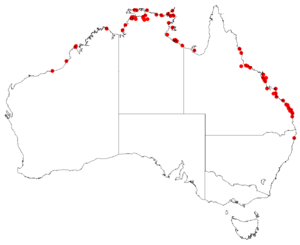Amyema mackayensis facts for kids
Quick facts for kids Amyema mackayensis |
|
|---|---|
| Scientific classification | |
| Genus: |
Amyema
|
| Species: |
mackayensis
|
 |
|
| Collections data for A. mackayensis from the Australasian Virtual Herbarium | |
The Amyema mackayensis, also known as the mangrove mistletoe, is a fascinating plant. It's a type of flowering plant that belongs to the Amyema genus. This special plant is an epiphyte, which means it grows on other plants, usually trees, without touching the ground. It's also a hemiparasitic plant, meaning it gets some of its food and water from its host plant, but it can also make its own food using sunlight.
You can find the mangrove mistletoe in Australia, along its northern and eastern coasts. It grows in places like New South Wales, Queensland, the Northern Territory, and Western Australia. It also lives in New Guinea.
What it Looks Like
The leaves of the mangrove mistletoe are quite unique. They grow in pairs, opposite each other on the stem. Each leaf has its own small stem and is thick, fleshy, and round. These leaves can grow up to 6 centimeters (about 2.4 inches) long.
When the plant flowers, its blossoms appear in special groups. These groups are called "umbels." An umbel is like a tiny umbrella shape where the flower stalks come from a single point. Each umbel usually has two or more "triads" (groups of three flowers) or "tetrads" (groups of four flowers). The flower buds are long and cylindrical, and they are usually smooth or have only a few scattered hairs.
Where it Lives and How it Survives
The Amyema mackayensis plant loves to live near the coast. It is often found in areas where the land meets the sea, especially in mangrove forests. It particularly likes to grow on the Grey Mangrove, which has the scientific name Avicennia marina.
Scientists have observed something very clever about this mistletoe. It seems to collect extra salt in its leaves. Since it grows in salty coastal areas, this helps it deal with the high salt levels. When the salt builds up too much, the plant simply sheds those salty leaves. This way, it gets rid of the extra salt and stays healthy.
Its Name and History
The mangrove mistletoe was first officially described in 1922. A botanist named William Blakely gave it the name Loranthus mackayensis at that time.
However, a few years later, in 1929, another botanist named Benedictus Danser decided to move it to a different group of plants. He placed it in the genus Amyema, which is why its scientific name today is Amyema mackayensis.

